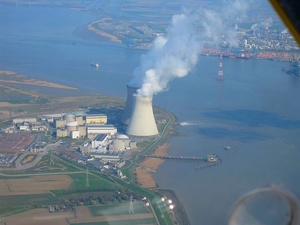
New Managing Director for Bellona Norway
The Board of the Bellona Foundation has appointed former Minister of Climate and the Environment Sveinung Rotevatn as Managing Director of Bellona No...
News

Publish date: August 10, 2012
Written by: Charles Digges
News
Belgium, like Germany and Switzerland, has decided to shut down its nuclear power program by 2025 in the wake of the Fukushima Daiichi disaster in 2011.
But the wear and tear on one of its reactor vessel is an alarming sign for at least three other European countries and possibly more worldwide, all of which purchased vessels from the same now-bankrupt Dutch manufacturer.
Nils Bøhmer, Bellona’s general director and nuclear physicist said that similar problem will begin to appear worldwide due to ageing nuclear reactors, whose average lifespan is about 30 years.
The wear and tear observed in Beligium, said Bøhmer, “is something that comes of neutron radiation from power generation” within the reactor core that is housed by the vessel.
“This will, as reactors get older, cause cracks,” in reactor vessels said Bøhmer.
The 1,006 MW Doel No 3 reactor, operated by GDF Suez unit Electrabel, is scheduled to close in 10 years according to the nuclear exit plan the Belgian government adopted in July. A pressurized water reactor, it went into service in 1982
The suspected fractures at the reactor, 25 kilometers north of Antwerp near the Dutch border, which provides a sixth of Belgium’s nuclear-generated power, do not pose any health and safety threat, said AFCN, the country’s nuclear watchdog.
Some 9 million people live within a 75 kilometer radius of the plant.
Belgian government nuclear regulator FANC said in a statement that it “will only give a permit for further operation if convincing arguments can be made. The aim is to guarantee safety.”
“An investigation of the vessel with the use of a new type of ultrasound equipment was carried out during planned maintenance of the No 3 reactor at the Doel Nuclear Power plant,” read a statement posted in Dutch on FANC’s website earlier this week.
“Although the analysis of the results of the ultrasound monitoring are not yet complete, many indications point to the discovery of cracks,” the statement continues.
The FANC statement went on to read that the Doel No 3 reactor has been stopped and its fuel elements have been removed.
But according to source that spoke with Bellona, GDF Suez unit Eletrabel wants to continue using the reactor after the scheduled maintenance is complete, even with possible cracks in the tanks, which could lead to a very dangerous situation.
“The problem with the reactor’s vessel is extremely serious because of the role the vessel plays in protecting people and the environment from radiation and radionuclides,” wrote Nicolas Parent of the Belgian Party of Greens in and email interview with Bellona.
“According to our information, the same position is supported by FANC, the administrators of which in internal communications do not rule out a permanent stoppage and decommissioning of the reactor as a result of the discovered problems,” wrote Parent.
According to preliminary analysis, the steel vessel was produced by Rotterdam Drydocks, a Dutch company that went bankrupt in the mid-1980s.
Several other nuclear sites around the world – including the US, Germany and Spain – use tanks produced by the same company, a nuclear energy expert who asked not to be named told the Financial Times.
Karina De Beule, AFCN spokeswoman, said the regulator had been in touch with its counterparts around the world, but had been unable to determine how many reactors abroad use vessels similar to the one at Doel.
“We are talking with all regulators as we would in any emergency situation . . . it is essential to co-ordinate efforts,” said De Beule in comments to the Financial Times. “At present, we can guarantee that there are no risks to workers, citizens and the environment.”
The reactor vessel is one of the most important safety elements, both holding hot water under pressure and preventing the escape of radionuclides into the environment. Theoretically, should Doel No 3’s vessel be damaged, a cement barrier surrounding it would prevent further spread of radionuclides.
Possible problems with the vessel were first suspected by FANC in June, it said on its website statement. The agency has also promised to publicize a dossier of its data confirming that the cracks “do not threaten the structural integrity of the reactor vessel,” suggesting that the regulator is attempting to justify the reactor’s further use.
In Bøhmer’s opinion, this would be ill advised.
“Any cracks in a reactor vessel must be taken seriously and lead to a proper rehabilitation of the vessel before the reactor is put back online,” he said.
Rehabilitation would mean, said Bøhmer, repairing the vessels cracks if possible. Another possible route of restoring power generation, he said, would be to place restrictions on how much energy the reactor is allowed to generate, thus reducing the possibility of further cracking.
FANC promised in its statement to conduct checks of all of Belgium’s seven reactors’ vessels using the ultrasound technology that revealed the possible cracks at Doel’s No 3 reactor.
Andrei Ozharovsky contributed to this report.

The Board of the Bellona Foundation has appointed former Minister of Climate and the Environment Sveinung Rotevatn as Managing Director of Bellona No...

Økokrim, Norway’s authority for investigating and prosecuting economic and environmental crime, has imposed a record fine on Equinor following a comp...

Our op-ed originally appeared in The Moscow Times. For more than three decades, Russia has been burdened with the remains of the Soviet ...

The United Nation’s COP30 global climate negotiations in Belém, Brazil ended this weekend with a watered-down resolution that failed to halt deforest...